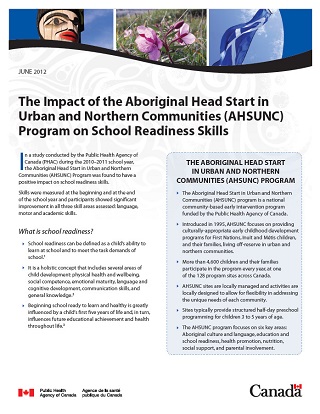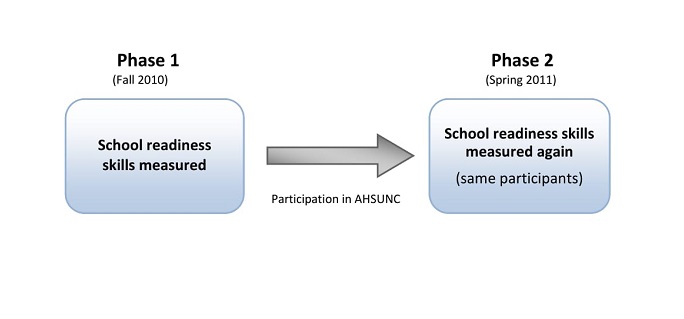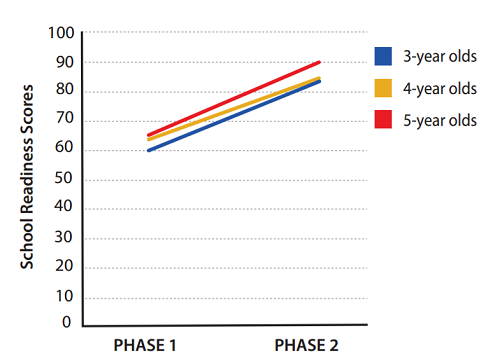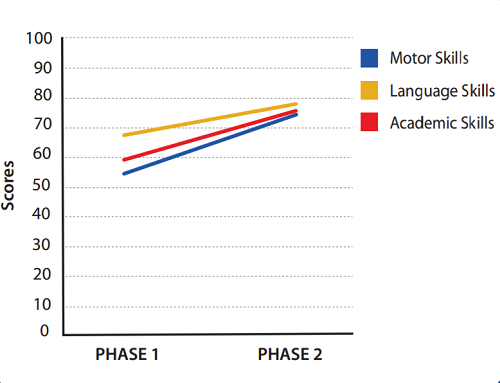The Impact of the Aboriginal Head Start in Urban and Northern Communities (AHSUNC) Program on School Readiness Skills
In a study conducted by the Public Health Agency of Canada (PHAC) during the 2010–2011 school year, the Aboriginal Head Start in Urban and Northern Communities (AHSUNC) Program was found to have a positive impact on school readiness skills.
Skills were measured at the beginning and at the end of the school year and participants showed significant improvement in all three skill areas assessed: language, motor and academic skills.
What is school readiness?
- School readiness can be defined as a child’s ability to learn at school and to meet the task demands of school.Footnote 1
- It is a holistic concept that includes several areas of child development: physical health and wellbeing, social competence, emotional maturity, language and cognitive development, communication skills, and general knowledge.Footnote 2
- Beginning school ready to learn and healthy is greatly influenced by a child’s first five years of life and, in turn, influences future educational achievement and health throughout life.Footnote 3
The Aboriginal Head Start in Urban and Northern Communities (AHSUNC) Program
- The Aboriginal Head Start in Urban and Northern Communities (AHSUNC) program is a national community-based early intervention program funded by the Public Health Agency of Canada.
- Introduced in 1995, AHSUNC focuses on providing culturally-appropriate early childhood development programs for First Nations, Inuit and Métis children, and their families, living off-reserve in urban and northern communities.
- More than 4,600 children and their families participate in the program every year, at one of the 128 program sites across Canada.
- AHSUNC sites are locally managed and activities are locally designed to allow for flexibility in addressing the unique needs of each community.
- Sites typically provide structured half-day preschool programming for children 3 to 5 years of age.
- The AHSUNC program focuses on six key areas: Indigenous culture and language, education and school readiness, health promotion, nutrition, social support, and parental involvement.

What is the AHSUNC School Readiness Study?
- The AHSUNC School readiness Study was conducted by PHAC to examine the impact of the AHSUNC program on school readiness skills. It focused on three key areas of school readiness: language, motor and academic skills.
- The skills of participants 3 to 5 years of age were assessed by their local AHSUNC teachers at the beginning (Fall 2010) and again at the end (Spring 2011) of the school year.
- Participation in this study was voluntary and parental consent was required for a child to participate. Guidelines ensured that no information identifying the children was shared and ID numbers were used to protect the anonymity of participants.
Figure 1. School readiness skills were assessed in a two-phased approach.

Figure 1 - Text Description
The school readiness skills of participants three to five years of age were assessed in two phases. They were assessed by local AHSUNC teachers at the beginning of the school year in Fall 2010 (Phase 1) and again at the end of the school year in Spring 2011 (Phase 2).
How were school readiness skills measured?
- School readiness skills were measured using the Brigance Head Start Screen, a tool used to assess three key areas of child development: language, motor and academic skills.
- The screen consists of a series of questions that are asked to each child individually. Depending on the question, the child is asked to provide a verbal or written answer, or attempt a certain task. A different age-specific screen was used for 3, 4 and 5-year-olds.
- To take into account the cultural context of the AHSUNC population, certain adaptations were made to the administration of the Brigance screen, including, for example, accepting a different word when asking the child to identify a picture (e.g., for a picture of a boat, the word canoe was acceptable, as was any other local word typically used for boat).
How many children and program sites participated in the study?
- Over 100 AHSUNC program sites across Canada (approx. 80% of all sites)
- Over 2,300 children in Phase 1
- Over 1,800 children in Phase 2 (Only 3% of the sites who participated in Phase 1 did not participate in Phase 2. Approximately a fifth of the Phase 1 participants did not participate in Phase 2)
- 1,310 participants included in the analyses (those who participated in both phases and met all inclusion criteria), representing approximately 33% of all 3 to 5 year old AHSUNC participants
What did we learn?
1. Participants showed significant progress in school readiness skills over the course of the school year.
Figure 2. All age groups improved significantly over the course of the year

Figure 2 - Text Description
All age groups improved significantly over the course of the year
Three four and five year old age groups' school readiness skills improved from Phase 1 to Phase 2.

Figure3- Text Description
Participants improved significantly in all three skill areas measured including motor, language and academic skills from Phase 1 to Phase 2.
Participants with and without special needs all showed significant improvement
Although participants with a diagnosed or suspected special need scored significantly lower in all three skill areas in Phase 1 and Phase 2, both groups progressed significantly over the course of the school year.
Both girls and boys progressed significantly over the course of the school year
Girls scored slightly higher than boys in Phase 1 and Phase 2; however, both girls and boys progressed significantly over the course of the school year.
Children who started out with the lowest levels of school readiness made substantial progress
Participants with the lowest scores at the beginning of the school year (Phase 1) improved more than participants with higher scores in Phase 1.
2. The AHSUNC program is having a positive impact on school readiness skills.
To assess whether the AHSUNC program had an effect on the progress observed or if progress was merely an effect of maturation (i.e., natural child development that would have occurred regardless of AHSUNC participation), two types of comparisons were made:
- the scores of AHSUNC participants were compared to ‘standard’ scores for children of their age;
- the scores of new AHSUNC participants at the start of the school year were compared to those of returning AHSUNC participants.
These comparisons both provided evidence that the AHSUNC program is having a positive impact on the school readiness skills of its participants.
When compared to age-specific norms, AHSUNC participants made substantial progress during the school year
Participants’ scores were compared to age-specific norms, which represent the ‘typical’ performance of children in each of the skill areas.
The results from this comparison show that AHSUNC participants started out at the beginning of the school year performing below the age-specific norms, and progressed to having scores similar to the norms by the end of the school year.
Participants who had previously participated in AHSUNC had higher scores at the beginning of the school year.
Participants who had previously attended the AHSUNC program, before the 2010-11 school year, had higher scores in Phase 1 than participants who were in their first year of AHSUNC programming.
This findings suggests that improvements in school readiness from the previous year of participation in the program were carried over and measurable at the start of the next school year.

Figure 4 - Text Description
The examination of relative progress of study participants over the course of Phase 1 and Phase 2 was done using comparison with standardized age-specific norm scores. This comparison showed that AHSUNC participants started out at the beginning of the school year performing below the standardized age-specific norm scores. AHSUNC participants had an average school readiness score of 68 as compared to the age-specific norm/average score of 77.
However, AHSUNC participants progressed to having scores similar to the norms by the end of the school year. AHSUNC participants now had an average score of 81 versus the age-specific norm/average scores of 80.
3. The Brigance Screen was useful for AHSUNC sites and teachers
In addition to supporting program evaluation, the Brigance Screen can be useful for local AHSUNC sites. By assessing a variety of skills, the screen can help teachers identify potential learning challenges, strengths and weaknesses.
It can also help site staff decide if a child should be referred for further assessment or if some participants could benefit from additional support in certain areas.
Finally, the screen can be used to help plan lessons, to measure progress throughout the year, or for discussions with parents and caregivers about their child’s development.
- A majority of sites (67%) found the results from the Brigance Screen useful for organizing their program.
- Sites who felt that the results had been useful indicated that it gave them information on the developmental areas they needed to focus on in their programming and the specific needs of each child.
- Many sites also noted that the results were helpful for lesson planning and provided ideas for types of activities to incorporate into their programming.
In Summary
The AHSUNC program is successful in producing measurable impacts on children’s school readiness. Over the course of the school year, AHSUNC participants improved significantly in all three skill areas assessed: language, motor and academic skills.
Although there were some differences in the level of progress achieved by certain groups of children, all groups improved significantly over the course of the school year.
By helping its participants improve their school readiness skills and be better prepared for school, the AHSUNC program plays an important role in the healthy development, later educational success, and future health outcomes of Indigenous children.
Acknowledgements
Many individuals and groups made this project possible. Firstly, we would like to thank the children and parents, as well as the AHSUNC sites and their staff, who took part in this study; without their active participation, this initiative would not have been possible. Secondly, we would like to thank the members of the National Aboriginal Head Start Council (NAHSC) and PHAC’s program consultants who supported this initiative and provided feedback along the way.
The implementation of this national initiative was informed by the experience from evaluation initiatives undertaken by the Western Arctic Aboriginal Head Start Council (WAAHSC) in the Northwest Territories, the Yukon Aboriginal Head Start Council (YAHSC), the Nunavut Inuit Head Start Council (NIHSC), the Alberta AHSUNC Provincial Committee, as well as the Atlantic AHS Committee. These community-based initiatives were very helpful in guiding our work.
Finally, we would like to thank the consulting fims who contributed to this study: Dale McMurchy Consulting, Goss Gilroy Inc., as well as Dr. Jennifer Chalmers who shared her expertise and advice throughout the study.
References
- Footnote 1
-
Offord Centre for Child Studies (2004). Early Development Instrument (EDI): A population-based measure for communities – Factsheet. Hamilton, ON: McMaster University.
- Footnote 2
-
Janus, M., Hughes, D. & Duku, E. (2010). Patterns of school readiness among selected subgroups of Canadian children: Children with special needs and children with diverse language backgrounds. Offord Centre for Child Studies. Hamilton, Ontario: McMaster University. www.offordcentre.com/readiness/files/2010_05_06_SR_subgroups_SN_Lang_CCL.pdf
- Footnote 3
-
Wold, C., Nicholas W. Starting school healthy and ready to learn: using social indicators to improve school readiness in Los Angeles County. Prev Chronic Dis 2007;4(4). www.cdc.gov/pcd/issues/2007/oct/07_0073.htm.